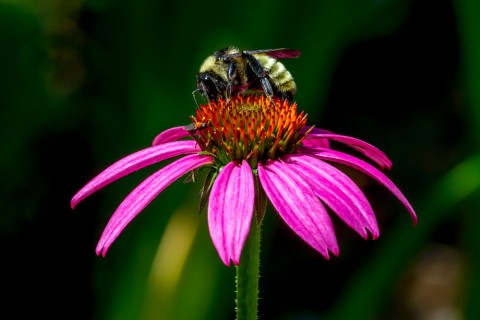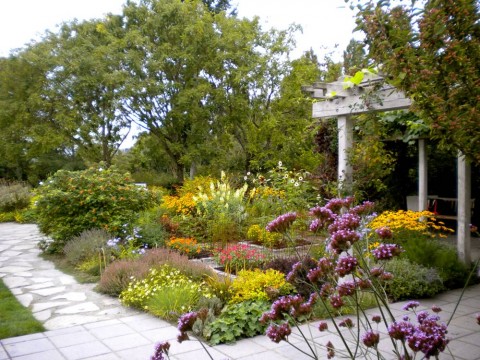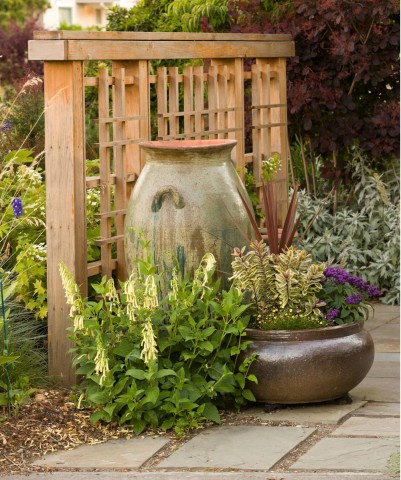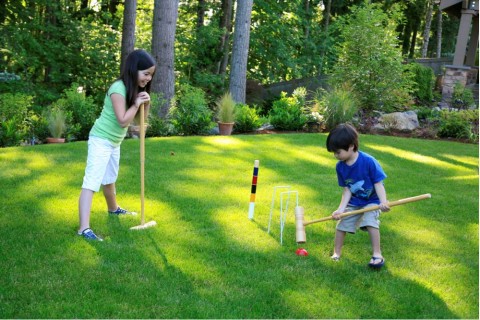5 Myths of Sustainable Gardening
Myth 1: One person can’t make a difference

Pollinators, such as bumblebees, thrive in gardens cared for sustainably.
Truth:
Ladd is quick to point out that each garden or landscape can either be a tiny source of the problem or it can be a tiny source of the solution. If you doubt that sustainable gardening practices make a difference, consider the changes you will see in your own backyard and their environmental impact.
Sustainable Practices Make a Difference
| Do This | Benefits in Your Garden | Environmental Benefits |
|---|---|---|
| Add organic matter to your soil, such as compost. | Plants will be healthier and grow stronger. Edible plants will produce a greater harvest. Organic matter holds water and can improve drainage. | Soil will hold more water thus conserving it for other uses. Organic matter filters pollutants. |
| Eliminate the use of insecticides. | Beneficial insects, like lady bugs and green lacewings, and birds will return to eat the damage causing insects. | Improves water quality for humans and for fish and other aquatic life. Protects beneficial insects. |
| Select plants that thrive in your environmental conditions. | You will have less work and anxiety about a garden that fails to thrive. | Plants that thrive reduce the need for chemicals thereby reducing these pollutants in the environment. |
| Mulch garden beds. | You will be watering less often during dry spells which saves you time and money. Mulch also protects the soil surface from erosion during heavy rain storms and suppresses weed growth. | Conserves water, saves top soil from washing away which can clog waterways and impact aquatic life. |
| Right-size your lawn. | Less lawn means less time and money spent on routine maintenance and more space for flowers and foliage, wildlife habitat and edibles. | Smaller lawns and more garden beds helps water percolate into the ground rather than run off into storm drains and waterways. |
| Choose plants that support wildlife. | Birds, butterflies, bees will flock to your garden for food and shelter. | Improves populations of birds, butterflies and bees which are essential for pollination and natural pest control. |
Myth 2: Sustainable gardening is an all or nothing proposition
This myth is a corollary to Myth 1. People often believe that they must adhere to every sustainable gardening practice in order to be a sustainable gardener.
Truth:
Sustainability is a philosophy that encourages protection of natural resources and espouses working with nature instead of against it. Mark Gile explained that “Any change to sustainable practices that you make, whether one, two, few or many, is practicing sustainable gardening.” Changing a few practices makes adopting more of them that much easier and more gratifying. “You’ll get hooked,” Mark added.
For instance, you are gardening sustainably when you:

Pulling weeds keeps damaging herbicides
out of your garden.
- Pull weeds instead of dosing them with chemicals
- Add compost or other mulch to your planting beds
- Use a mulching lawn mower
- Grow food to feed your family
- Use renewable resources (e.g., organic fertilizers and mulches)
- Conserve water and reduce runoff
- Capture and/or retain rainwater on your property
- Add nectar-rich plants to feed birds, bees and butterflies
- Participate in local yard waste composting programs or make your own compost
- Choose the right plant for your environmental conditions
- Choose drought tolerant plants that suit your style and preferences
- Select plant varieties that are disease and pest resistant
- Use recycled materials for structures
Myth 3: Gardening sustainably is too expensive
Ladd Smith and Mark Gile think this misconception is prevalent because some homeowners make a financial investment to get their garden going in a “sustainable” direction. For example, they may build raised vegetable beds, contour an area for a rain garden, buy a load of compost to improve the soil or switch to organic fertilizers that cost a little more.
Truth:
Gardening sustainably does not require that you make expensive changes to your landscape. Nor does adopting sustainable practices necessarily cost you more. In fact, sustainable gardening, over time, can actually reduce the cost of creating and caring for a garden or landscape and the time needed to maintain it.
- If you choose to make significant changes to your landscape, consult the experts when designing or redesigning your garden or landscape. Design professionals and a myriad of published information can help you move toward a more sustainable garden design. An investment in gathering information will save you time and money in the long run.
- Amend soil with organic matter. The initial investment pays off in healthier plants, increased yield of produce, and less need for pest control, watering and fertilization which saves both money and time.

The Waterwise Garden at the Bellevue Botanical Garden shows a wide diversity of drought
tolerant plants. Click here for a list.Choose plants that are drought tolerant and are pest and disease resistant. They do not cost more and will save you money and time on watering and pest controls.
- If plants already in your garden or landscape can be grown sustainably, keep them. This will reduce the cost of new plants in your sustainable garden and will give instant benefits and immediate gratification. Keeping healthy, disease-free trees should be the number one priority.
- Ask for and use recycled and locally sourced materially for hardscapes. They often cost less than materials shipped from elsewhere. Find a supplier that will work with you.
- Use LED fixtures for outdoor lighting. The initial investment pays off in long term saving in energy costs.
- Use efficient watering methods such as water timers and drip irrigation. Using less water saves money whether you buy water from a public utility or pay the cost of electricity to pump water from your own well.
- Eliminate unnecessary pruning by choosing plants that will not outgrow their space. Then let them grow to their natural size and shape. Unnecessary pruning and shearing is a drain on your time, and if you use a professional, a drain on your finances.
Myth 4: Sustainable gardens are not my style

This small courtyard garden has drought tolerant plants, feeds birds and bees, has space between pavers to allow water to soak into the ground, has mulched planting beds and uses recycled materials (Designed by In Harmony Sustainable Landscapes)
People often think that sustainable gardens look a certain way. They may look like a desert landscape made up of rocks, succulents and cactus. Or, they might look like a forest full of only native trees, shrubs and ferns with very few flowers. Or, that a sustainable garden is a rain garden and rain gardens are a dip in the lawn with a few scraggly plants.
Truth:
What makes a garden sustainable is the result of the conscientious actions you take—how you care for the soil, what plants you choose, the way you care for the plants, the hardscapes materials and accents you use, and so on—not the style.
A sustainable garden can be of any style or theme you choose from formal to cottage and contemporary to eclectic. Mark shared that “a well-designed drought-tolerant landscape, for instance, can be filled with a lush variety of colorful plants that have year-round beauty and give no outward clues that it was created to conserve water and eliminate chemical usage.”
- To reduce water use, choose drought tolerant plants for sunny, dry spots. Many are available that can give you a very similar look to the “traditional” plants you might otherwise choose. The website greatplantpicks.org is a great resource for identifying plants with low water needs that have the look, color and form you want for your garden or landscape.
- To reduce pesticide use, choose plants that grow well in Pacific Northwest weather and soil conditions and are resistant to pests and disease. Natives are not your only choice. Check out greatplantpicks.org for ideas.
- To support wildlife, choose plants that provide food and shelter for birds, butterflies, bees and other wildlife within the context of your design.
- Incorporate edible plants among the ornamental ones to feed yourself, your family and to donate.
- When creating large entertainment areas, allow rainwater to percolate back into the ground by leaving spaces between pavers or use crushed local rock instead of concrete.
- Resize your lawn to only what is necessary to achieve the desired effect.
- Use sustainable care practices such as: fertilizing wisely by timing applications to when plants need it, by following the rates found on the package, and by switching to organic fertilizers; pull weeds or spot treat them; and, use least toxic pest controls when the damage to the plant warrants it.
- Top off garden beds with mulches made of organic materials (e.g., compost, untreated wood chips, aged manures) to conserve water, suppress weeds and help plants survive harsh weather conditions. Avoid synthetic or dyed mulches.
Myth 5: Gardening sustainably means I can’t have a lawn
Advocates for sustainable gardening point out that lawn fertilizers, weed killers and gas powered lawn mowers can be a significant source of water, air and noise pollution. And, over-watered lawns waste a precious resource.
With so many inherent risks of damage to the environment, many homeowners conclude that lawns are taboo if you garden sustainably.
Truth:
You can have a lawn. When kids, families and pets need a soft place to play and relax, no other plant quite fits the bill as perfectly as turf grass. You just need to adopt some new practices to make lawns sustainable.

Care for lawns with sustainable practices in mind. (Designed by In Harmony Sustainable Landscapes)
- Right-size your lawn for the purpose you want to achieve such as to provide a play area for the kids and dog, or to create a little green oasis among beds of plants.
- Plant lawns where they grow best: full sun on well-draining soil. Choose other plants for shady, damp and sloped places.
- Adjust mowing height to leave grass blades 3 inches tall. This lawn height also shades the soil surface reducing water evaporation.
- Convert to a mulching mower and let nutrient-rich clippings decompose and naturally “fertilize” the lawn. For smaller lawns, a rechargeable or an electric mulching mower will usually do the job just fine and will eliminate gas emissions.
- Water deeply, 1 inch once per week. It’s best to water once or twice weekly rather a little bit every day. This promotes growth of deep roots making the lawn more drought tolerant and a tougher, more resilient plant.
- Consider letting lawn go dormant in summer. It will be green 9-10 months of the year and when it is dormant you can take a break from mowing! A healthy lawn will bounce back in the fall when rains return. If you choose to let the lawn go dormant, it is important to water one day a month with 1 inch of water to keep some moisture in the soil profile.
- Don’t spread weed and feed products on lawns. Why apply weed killers everywhere when you may only have a few weeds? Pull or spot treat weeds instead.
- Fertilize organically. Use compost to top dress lawns in April or May; use slow release organic nitrogen-based fertilizer in September or October and follow application rates as directed.
- Aerate and overseed lawns annually in spring or fall. Aeration will alleviate compaction and open up the soil profile to air and water. Overseeding with a Northwest or sun/shade blend of seed. Look for perennial rye and fine fescue grasses in the blend.
Learn more about how to “go sustainable” with In Harmony Sustainable Landscapes.
